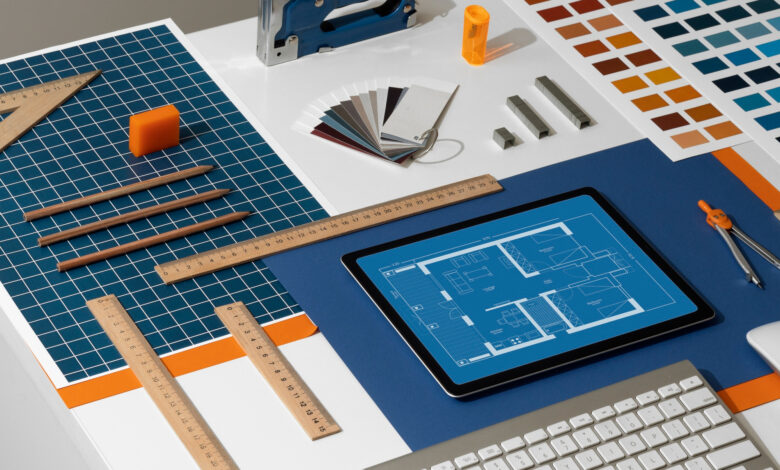10 Principles of Good Architectural Design

Introduction
Architectural design is more than just constructing buildings; it’s about creating spaces that are functional, aesthetically pleasing, and harmonious with their surroundings. A well-designed structure not only meets the needs of its users but also stands as a testament to creativity, innovation, and thoughtful planning. The importance of good architectural design cannot be overstated as it impacts everything from the usability of a space to the well-being of its occupants and even the environmental footprint of the building.
In this article, we will explore the 10 principles that define good architectural design. These principles serve as a guide for architects, designers, and anyone interested in understanding what makes a building not just good, but great.
Principle 1: Functionality
At the core of good architectural design is functionality. A building must first and foremost serve its intended purpose. Whether it’s a home, office, hospital, or school, the design should cater to the specific needs of its users. Functionality in architecture means that every element of the building, from the layout to the materials used, contributes to its efficiency and effectiveness.
For example, in a residential design, functionality might involve optimizing space for daily living activities, ensuring that there is enough natural light in living areas, and providing easy access to essential facilities like kitchens and bathrooms. A well-functioning building improves the quality of life for its occupants by making everyday tasks easier and more enjoyable.
Principle 2: Aesthetics
Aesthetics are the visual aspects of a building, and they play a crucial role in how a structure is perceived. Good architectural design strikes a balance between beauty and practicality. A building should not only be visually appealing but also reflect the identity and values of its occupants or the community it serves.
Architects use various elements like proportion, scale, and harmony to create aesthetically pleasing designs. However, aesthetics should not come at the expense of functionality. A beautiful building that is uncomfortable or impractical to use fails in its purpose. The key is to integrate aesthetic appeal with functional design, creating spaces that are both beautiful and livable.
Principle 3: Sustainability
In today’s world, sustainability is an essential principle of architectural design. Sustainable design practices focus on reducing the environmental impact of buildings by using eco-friendly materials, energy-efficient systems, and designs that work in harmony with the environment.
For instance, incorporating solar panels, green roofs, and rainwater harvesting systems can significantly reduce a building’s carbon footprint. Sustainable architecture is not only good for the planet but also for the occupants, as it often leads to healthier living environments and reduced operating costs.
Principle 4: Harmony with Environment
A building should enhance, not detract from, its surroundings. This principle involves designing structures that complement the natural landscape and existing built environment. Harmony with the environment can be achieved by considering the site’s topography, climate, and vegetation during the design process.
Successful examples of environmental integration include homes built into hillsides, which blend seamlessly with the landscape, and urban buildings that incorporate green spaces and natural light to soften the impact of the concrete jungle. The goal is to create a building that feels like a natural extension of its environment.
Principle 5: Flexibility and Adaptability
The needs of building users can change over time, so flexibility and adaptability are important considerations in architectural design. A flexible design allows spaces to be reconfigured or repurposed as needed, without requiring significant structural changes.
For example, open-plan offices are a popular choice because they can be easily adapted to accommodate different work styles and team sizes. Similarly, modular housing designs allow for easy expansion as a family grows. By planning for the future, architects can create buildings that remain functional and relevant for many years.
Principle 6: Safety and Durability
Safety is a non-negotiable aspect of good architectural design. Buildings must be designed to withstand the forces of nature, such as earthquakes, floods, and high winds, as well as everyday wear and tear. This requires the use of durable materials and construction techniques that ensure the building’s longevity.
In addition to structural integrity, safety also involves designing spaces that are accessible and secure for all users. This includes everything from fire escapes and emergency exits to secure entry systems and adequate lighting in common areas. A safe building protects its occupants and stands the test of time.
Principle 7: User-Centric Design
Good architectural design prioritizes the needs and experiences of the building’s users. This means designing spaces that are comfortable, accessible, and easy to navigate. User-centric design also takes into account the psychological and emotional impact of the space on its occupants.
For example, hospitals are designed to reduce stress and promote healing by incorporating natural light, calming colors, and outdoor spaces. Similarly, schools are designed to support learning and creativity with flexible classrooms and ample recreational areas. By understanding the needs of users, architects can create spaces that enhance their well-being and productivity.
Principle 8: Innovation and Creativity
Innovation and creativity are what set great architecture apart. These principles involve pushing the boundaries of conventional design, exploring new materials, technologies, and ideas. Innovative architectural design can solve complex problems, create unique spaces, and inspire future generations of architects.
For instance, the use of 3D printing in construction has opened up new possibilities for creating complex and customized structures with minimal waste. Similarly, the integration of smart technologies into buildings allows for more efficient energy use and improved user experiences. Embracing innovation keeps architecture fresh, relevant, and exciting.
Principle 9: Cost-Effectiveness
While good design is important, it must also be achievable within a given budget. Cost-effectiveness in architecture means finding ways to deliver high-quality design without overspending. This can involve choosing cost-effective materials, optimizing construction methods, and minimizing waste.
Architects often work closely with clients to ensure that the design meets both aesthetic and functional goals while staying within budget. This might involve making trade-offs or finding creative solutions to achieve the desired outcome without compromising on quality. A cost-effective design is one that maximizes value for both the client and the community.
Principle 10: Cultural and Contextual Sensitivity
Architecture is not just about buildings; it’s about the people who live, work, and interact within those spaces. Good architectural design reflects the culture, history, and context of its location. This principle involves designing buildings that resonate with the local community, respect cultural traditions, and contribute to a sense of place.
For example, traditional building materials and techniques might be used in a way that honors local heritage while incorporating modern amenities. Similarly, public spaces might be designed to encourage community interaction and cultural expression. By considering the cultural and contextual factors, architects can create designs that are meaningful and impactful.
Conclusion
The 10 principles of good architectural design outlined in this article provide a comprehensive guide for creating buildings that are not only functional and beautiful but also sustainable, safe, and user-centric. By adhering to these principles, architects can create spaces that enhance the lives of their occupants, contribute positively to the environment, and stand the test of time.
The future of architectural design will continue to evolve as new technologies, materials, and ideas emerge. However, the core principles of good design will remain constant, serving as a foundation for creating structures that inspire, innovate, and endure.
Call To Action
Ready to transform your vision into reality? Whether you’re looking for residential, commercial, or farmland, we’ve got the perfect land for your next project. Visit our website at reapse.co to explore our listings and make your purchase today. Start building your future with us!
FAQs
1. What is the most important principle in architectural design?
The most important principle is functionality, as a building must first meet the needs of its users. However, good design integrates all principles harmoniously.
2. How can architecture be both beautiful and functional?
Architecture achieves both beauty and functionality by balancing aesthetic elements with practical needs. Effective designs use proportions, materials, and layouts that enhance visual appeal while ensuring usability and comfort.
3. What role does technology play in modern architecture?
Technology in modern architecture allows for innovative designs, improved efficiency, and smarter buildings. Advances like 3D printing, smart building systems, and sustainable materials help architects push boundaries and create high-performance structures.
4. How does sustainability influence architectural design?
Sustainability influences architectural design by encouraging the use of eco-friendly materials, energy-efficient systems, and designs that reduce environmental impact. It promotes long-term thinking, leading to buildings that are not only environmentally responsible but also cost-effective and healthier for occupants.
5. Can architectural design impact mental well-being?
Yes, architectural design can significantly impact mental well-being. Well-designed spaces that incorporate natural light, green areas, and calming environments contribute to reduced stress, improved mood, and overall mental health.
Stay tuned on our website to stay updated on real estate news, gain insights on real estate tips, and enjoy real estate stories where realtors share their experiences. You can also make money by sharing your own story. Don’t forget to drop your comments and join the conversation!




